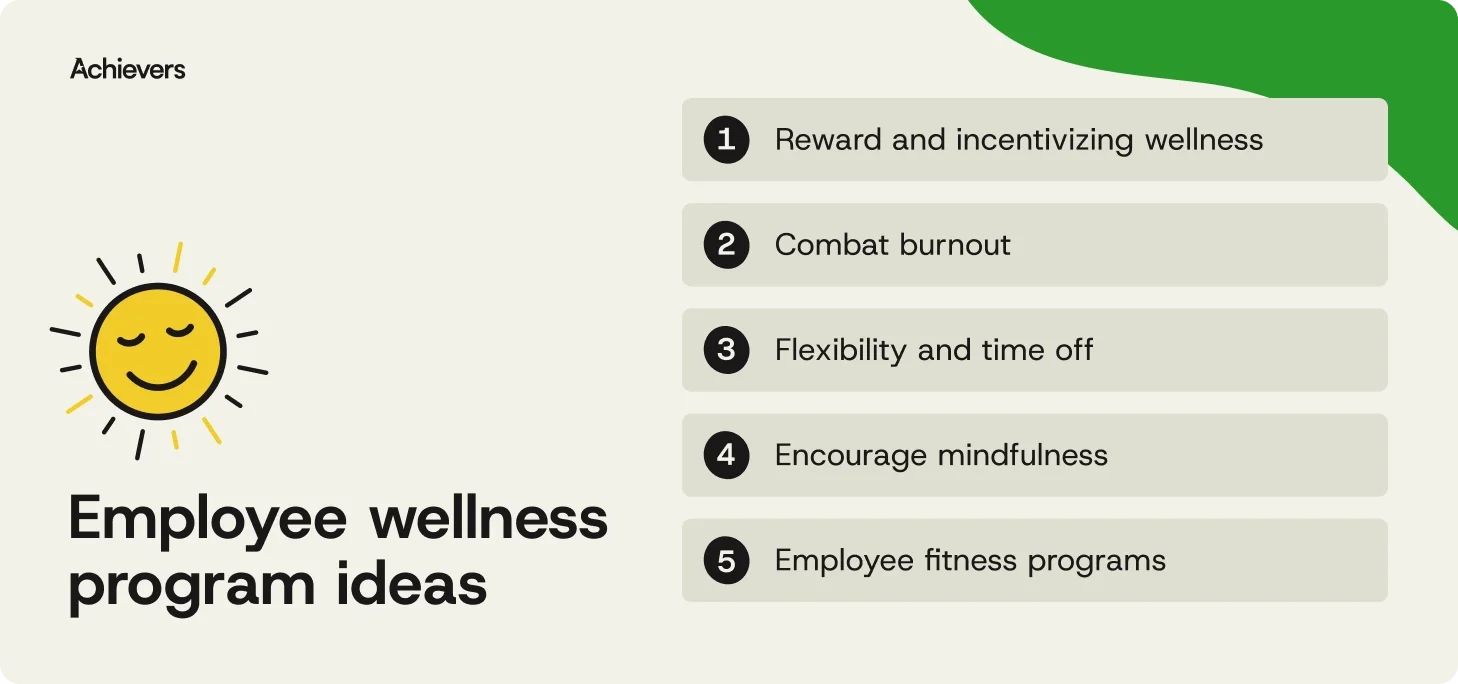Table of contents
Create a culture that means business™
Schedule a demo with an Achievers solution expert today.
What’s the cost of a stressed-out workforce? Turns out, it’s more than just a few off days. Burnout, illness, and mental health challenges can quietly drain your team — and your bottom line — to the tune of up to $3,600 per employee each year. That’s not exactly pocket change.
The good news? A thoughtful wellness program can flip the script. When you prioritize well-being, you don’t just cut back on absences — you build a workplace where people feel energized, connected, and ready to do their best work.
Curious where to start? We’ve rounded up 10 wellness ideas to help you build a healthier, happier team (no trust falls required).
What are employee wellness programs?
Employee wellness programs — or the corporate wellness program your team actually wants to participate in — are all about supporting physical, mental, and emotional well-being in ways that feel helpful, not like homework. Think stress management tools, mindfulness resources, fitness challenges people don’t roll their eyes at, and health services that don’t require an Olympic-level calendar sprint to access.
The goal is simple: help people feel good so they can do good work. But here’s the twist — wellness isn’t just about gym stipends and nutritious snacks. It’s about the everyday behaviors that shape how people show up. When employees feel recognized, supported, and connected, they’re more motivated to build healthier habits and stay engaged.
Why wellness programs are important
Workplace wellness programs matter because a healthy workforce is your direct line to stronger performance, better retention, and fewer burnout-fueled spirals.
- Healthier, more resilient teams: Employees who feel well can handle stress, change, and everyday workplace chaos with a lot more ease.
- Higher engagement and performance: Well-being fuels motivation, creativity, and follow-through — the trifecta every organization wants more of.
- Reduced absenteeism and presenteeism: When people aren’t running on fumes, they miss fewer days and make more of the days they’re actually in.
- Stronger retention: According to the National Library of Medicine, 81% of employees believe that how businesses support mental health, and well-being will be essential to their future employment decisions. Turns out, it’s a deciding factor in whether people stay, grow, and do their best work with you.
- A healthier workplace culture: Wellness programs show employees they’re valued as humans, not just headcount, strengthening morale and belonging.
10 ideas for employee wellness programs
Looking to support your team’s well-being without adding another “mandatory fun” meeting to the calendar? These wellness program ideas are designed to actually help — boosting health, morale, and maybe even a few smiles along the way.

1. Reward and incentivizing wellness
Let’s be honest: no one’s feeling inspired by a branded mug. Generic wellness rewards often miss the mark — and tracking them manually only adds stress. A better approach? Use a recognition and rewards program that syncs with your wellness tools.
Employees earn points automatically for hitting goals, then redeem them for rewards they actually want. It’s easy, personal, and motivating. Plus, it takes the pressure off HR to manage every detail. Employee wellness becomes more than a checkbox — it becomes something your team looks forward to. And that’s a win for everyone.
2. Combat burnout
Burnout isn’t a sign of hustle — it’s a red flag. With 77% of employees reporting burnout, it’s time to take it seriously. Start by listening. Anonymous pulse surveys can uncover what’s really driving stress, from heavy workloads to unclear expectations. The truth might be uncomfortable, but it’s essential.
Once you know what’s behind your employees’ burnout, take action. Set healthy boundaries, support mental well-being, and open up honest conversations. It’s not just about new policies — it’s about showing employees they’re seen, heard, and supported. Because when you care for your people, they bring their best to work.
3. Flexibility and time off
Wellness doesn’t clock in from 9 to 5. Flexibility in where, when, and how work gets done can make a big difference — especially in a world where remote and hybrid are the norm. Empowering employees to work in ways that suit them (and don’t derail the team) fosters autonomy, engagement, and balance.
Also key? Real time off. Encourage employees to actually use their PTO — no guilt, no side-eye. And make sure workloads aren’t so full they need a vacation just to prep for one. Flexibility and rest aren’t perks; they’re part of a healthy workplace.
4. Encourage mindfulness
Helping employees build mindfulness into their day doesn’t have to mean hour-long meditations. It could be as simple as offering access to mindfulness apps, guided sessions, or emotional intelligence (EQ) workshops. These tools help employees stay grounded, handle stress better, and communicate with more empathy. The result? A calmer, more connected workforce — and a culture that doesn’t crack under pressure.
5. Employee fitness programs
Fitness isn’t just about hitting the gym — it’s about helping employees feel better, think clearer, and work smarter. The WHO reports that inactive people face a 20–30% higher risk of death, which is… not exactly motivating. But your fitness programs can be.
You don’t need an in-office spin studio to make an impact. Walking clubs, yoga breaks, or virtual class stipends go a long way. Reimbursing gym memberships? Even better. It’s about offering options that get people moving — in ways they actually enjoy. Because healthier employees aren’t just more productive — they’re happier. And that’s a win-win.
6. Health services
Let’s be honest — squeezing in a doctor’s appointment between meetings isn’t always realistic. That’s where your organization can step up. Making health services accessible at work shows employees you’ve got their well-being in mind (and not just during flu season).
Think in-office flu shots, health risk assessments, or even wellness coaching. It’s proactive support that helps catch issues early and keeps your team feeling their best. Bonus: fewer sick days, more peace of mind. When healthcare feels convenient instead of complicated, employees are more likely to use it — and that’s a win for everyone.
7. Education
Healthy habits don’t just happen — they’re learned. And with so much wellness misinformation floating around, it’s worth giving employees the facts. Education is the backbone of any solid wellness program, helping your team make informed choices about their health.
Think beyond basics like preventative care and tackle the tricky stuff too — like vaccine myths or nutrition confusion. Share trustworthy resources through webinars, blogs, or quick-read newsletters. Better yet, invite an expert to host a session. When employees have the right info at the right time, they’re more confident, more empowered, and yes — healthier. According to Gallup, employees with high well-being are 41% less likely to miss work and 27% more likely to report excellent performance. Knowledge really is power.
8. Encourage healthy eating habits
We’ve all been there — one too many vending machine visits and suddenly the 3 p.m. slump hits hard. Helping employees make healthier food choices isn’t about banning cookies; it’s about making better options easier and more appealing.
That might mean offering nutritious office snacks, hosting the occasional healthy lunch, or sending snack boxes to remote teams. You can also share resources on balanced eating and local spots with better-for-you meals. The goal? Keep energy (and morale) high without the sugar crash. Because when people eat well, they feel better — and they’re way more likely to finish that report.
9. Smoking cessation programs
Kicking the habit isn’t easy — but with support, it’s absolutely possible. While smoking still affects over a billion people globally, judgment and finger-wagging won’t change that. What helps? Real resources and a whole lot of empathy.
Support your team with access to smoking cessation programs, like coaching, counseling, or even peer groups. Offer reimbursements for tools like patches or gum to make the journey easier (and less expensive). The message is simple: we’ve got your back, no pressure, no shame. Helping employees quit doesn’t just boost their health — it clears the air for everyone. Literally.
10. Commuter programs
The daily drive isn’t just hard on wallets — it can wear down well-being too. With nearly 70% of Americans commuting solo by car, employees are spending over $2,000 a year just to sit in traffic. Fun, right?
Encourage healthier, greener options like biking, carpooling, or transit. They’re good for the planet, the budget, and the mood. Want to make it stick? Offer perks — think gift cards, extra PTO, or a little public praise. Covering transit passes or bike gear helps too. Small nudges go a long way toward happier commutes (and fewer parking headaches). Everyone wins.
Key elements of a successful employee wellness program
The strongest corporate wellness programs blend the right components with clear goals — and they do it in a way that feels human, supportive, and actually doable in the real world. Here’s how:
1. Leadership support
Wellness only works when leaders are willing to walk the walk — not speed-walk past it on their way to another meeting. When managers model healthy behaviors, talk openly about well-being, and actively participate, employees take the program seriously.
A simple way to keep things grounded? Create a wellness committee with employees from across teams and tenures. It keeps the program honest, relevant, and far more effective than top-down guesses.
2. Team participation
Even the most well-intentioned wellness program can flop if no one joins. Employees need to understand what the program is, why it matters, and how it makes their work (and life) a little easier.
Clarity helps — but incentives and recognition help even more. When employees feel motivated and appreciated for participating, engagement becomes a habit, rather than a heavy lift.
3. Smart program design
Great wellness programs don’t start with a trend; they start with listening. When you understand what people actually need, you can design a program they’ll use — not one that disappears into slide 23 of an employee onboarding deck.
Don’t let wellness feel like an add-on
Building a culture of wellness isn’t about ticking boxes — it’s about creating a workplace where people feel supported, energized, and actually want to show up (even on Mondays).
By putting these 10 wellness ideas into action, you’re not just encouraging healthy habits — you’re showing employees that well-being is part of how you do business. With tools for recognition, feedback, and connection, Achievers helps make wellness feel like a natural part of your culture, not just another HR initiative.
Start small, listen often, and grow from there. Healthier teams build stronger companies. We’ll help you get there.



